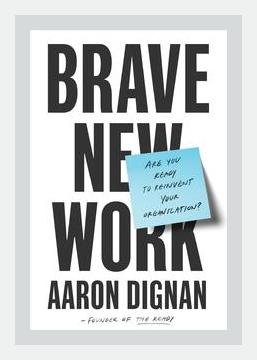Human Resources and Talent ManagementTechnology and Digital TransformationWorkplace CultureDigital Disruption
Introduction
Aaron Dignan’s “Brave New Work” is a compelling guide for leaders and organizations aiming to thrive in the unpredictable nature of the modern business world. The book delves into the necessities of workplace culture and addresses the challenges posed by digital disruption. Dignan advocates for a radical shift in organizational structures and behaviors, promoting a concept he calls the “Operating System” (OS) for organizations. Key themes include anti-fragility, adaptability, and human-centric work environments.
1. The Limits of Current Systems
Current organizational structures often operate on outdated assumptions, relying heavily on top-down control and rigid processes that stifle innovation and agility.
Action: Embrace Decentralization
– Example: Buurtzorg, a Dutch healthcare organization, operates with self-managing teams without traditional management, significantly improving patient satisfaction and reducing costs.
2. The Operating System Canvas
Dignan introduces the “Operating System Canvas,” a framework consisting of 12 interconnected domains that together represent an organization’s foundational elements: Purpose, Authority, Structure, Strategy, Resources, Innovation, Workflow, Meetings, Information, Membership, Mastery, and Compensation.
Action: Assess Your Organizational OS
– Example: A tech startup revisits its governance model, moving from a hierarchical structure to a network of teams, enhancing cross-functional collaboration and speeding up decision-making processes.
3. Purpose: The North Star
An organization’s purpose goes beyond profit, serving as a guiding principle that aligns and motivates employees.
Action: Define and Communicate Your Purpose
– Example: Patagonia’s mission to save the planet resonates with its employees, fostering loyalty and engagement that translates into innovative and sustainable business practices.
4. Authority: Distributing Power
Authority should be decentralized to empower individuals at all levels of the organization to take initiative and make decisions.
Action: Empower Teams with Decision Rights
– Example: Morning Star, a tomato processing plant, uses a model where employees negotiate roles and responsibilities directly with one another, increasing accountability and ownership.
5. Structure: From Rigid to Fluid
Structures should be dynamic and adaptable, allowing organizations to respond quickly to changes in the environment.
Action: Implement Dynamic Roles
– Example: A design firm adopts a holocratic structure where roles are not tied to individuals but organized around needed functions, encouraging fluidity and responsiveness.
6. Strategy: From Planning to Sensing
Traditional long-term strategic planning is less effective in a fast-changing world. Instead, organizations should focus on sensing and responding to emerging trends.
Action: Develop a Sensing Mechanism
– Example: An e-commerce company implements a system where each employee reports market insights weekly, enabling the company to pivot quickly based on real-time feedback.
7. Resources: From Scarcity to Abundance
Organizations must rethink resource allocation, seeing it not from a mindset of scarcity but one of abundance and flow.
Action: Foster Resource Fluidity
– Example: A consulting firm embraces a model where employees can allocate their time to projects they are passionate about, often leading to more innovative solutions and higher job satisfaction.
8. Innovation: Beyond the Silo
Innovation should not be confined to an R&D department; it should be a shared responsibility across the organization.
Action: Create Innovation Labs
– Example: Google’s “20% time” policy allows employees to spend 20% of their workweek on innovative projects of their choosing, leading to the creation of Gmail and Google News.
9. Workflow: From Linear to Iterative
Workflow should be iterative, promoting continuous improvement and agility.
Action: Adopt Agile Methods
– Example: Spotify uses “squads,” small cross-functional teams that work iteratively and independently on different aspects of the product, enhancing their ability to innovate and adapt.
10. Meetings: Intentional and Effective
Meetings should be intentional, well-facilitated, and designed to produce tangible outcomes.
Action: Redesign Meeting Practices
– Example: A marketing company redesigns its meeting structure, implementing stand-up meetings for quick status updates and reserving longer meetings for strategic discussions only.
11. Information: Transparent and Accessible
Transparency in information builds trust and empowers employees to make informed decisions.
Action: Open Access to Information
– Example: Buffer, a social media management company, practices radical transparency, sharing salaries, financials, and even decision-making processes with the entire team.
12. Membership: Valued and Inclusive
Organizations need to create a sense of belonging and inclusivity, where every member feels valued and heard.
Action: Foster Inclusive Cultures
– Example: The tech company Slack implements programs that support diversity and inclusion, such as employee resource groups and inclusive hiring practices, to ensure every voice is heard and respected.
13. Mastery: Continuous Learning
Continuous learning and development are essential for maintaining relevance and driving organizational success.
Action: Invest in Development Programs
– Example: An engineering firm provides regular opportunities for employees to engage in professional development through courses, workshops, and peer mentoring, enhancing collective expertise and adaptability.
14. Compensation: Fair and Transparent
Compensation should be clear, equitable, and aligned with organizational values and market standards.
Action: Implement Transparent Pay Structures
– Example: SumAll, a data analytics company, uses a transparent salary formula that is accessible to all employees, ensuring fairness and helping to attract and retain talent.
Conclusion
“Brave New Work” challenges traditional organizational paradigms and offers a detailed blueprint for transformation in the face of digital disruption and evolving workplace culture. By adopting the principles outlined in the Operating System Canvas, organizations can become more resilient, adaptable, and human-centered. Dignan’s actionable insights demonstrate that reinvention is not just a possibility but a necessity for future success.
Human Resources and Talent ManagementTechnology and Digital TransformationWorkplace CultureDigital Disruption
